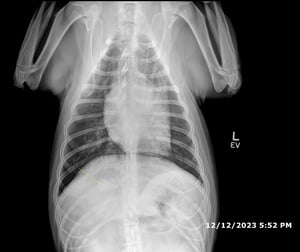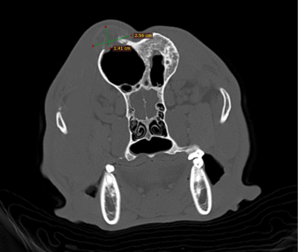
Pet Owners: What You Need To Know About CT Scans For Your Pet
HOW TO SCHEDULE AN APPOINTMENT
• Thursday is our outpatient CT scanning day.
• Appointments must be made through your referring veterinarian. They will be able to give you date options.
• At this time we are an appointment-based service and do not accept walk-ins.
• Requests for other days can be made by your referring veterinarian.
• Once we receive the referral from your doctor, we'll contact you with more specific appointment information.
• Review our Pet Owner consent form below.
• Appointments must be made through your referring veterinarian. They will be able to give you date options.
• At this time we are an appointment-based service and do not accept walk-ins.
• Requests for other days can be made by your referring veterinarian.
• Once we receive the referral from your doctor, we'll contact you with more specific appointment information.
• Review our Pet Owner consent form below.
HOW TO PREPARE YOUR PET
• Please drop off your pet at the specified time in your confirmation email.
• Withhold food from your pet after 8:00 pm the night before your appointment (unless instructed differently by your veterinarian).
• Allow your pet to drink water
• Give gabapentin/trazodone 1-3 hours before the appointment. (It’s ok to give medication with a small amount of food.)
• Be prepared to advise staff of the last time any food was eaten and when/what medications were given.
• Withhold food from your pet after 8:00 pm the night before your appointment (unless instructed differently by your veterinarian).
• Allow your pet to drink water
• Give gabapentin/trazodone 1-3 hours before the appointment. (It’s ok to give medication with a small amount of food.)
• Be prepared to advise staff of the last time any food was eaten and when/what medications were given.
PRE-VISIT MEDICATIONS, SEDATION, AND ANESTHESIA
We recommend consulting with your primary care veterinarian to obtain pre-visit medications. These medications, often used to address fear, anxiety, or stress related to veterinary care, can also reduce the amount of procedural sedatives needed during your pet's treatment. Recognizing that each patient responds differently to sedatives and anesthesia, our goal is to design a sedation and anesthetic plan that best suits your pet.
To ensure optimal care, our Board-Certified Anesthesiologist will assess your pet and develop a customized medication plan.
For the safety of our patients and to capture the highest quality images, pets undergoing a CT scan will be moderately sedated. This level of sedation keeps the patient calm, relaxed, and unconscious.
The injectable sedative used is short-acting, and a reversal agent can be administered after the procedure, allowing recovery within 15-20 minutes.
If your pet has breathing difficulties, our team may insert a breathing tube to maintain an open airway and provide oxygen.
In some cases, full anesthesia may be required.
Under general anesthesia, your pet will be connected to an anesthetic machine, and a tube will be placed in their trachea to deliver oxygen and inhalant anesthesia as they breathe.
Your pet will be discharged from the imaging center once they are fully awake and comfortable.
They may remain mildly sedated for the rest of the day and should be monitored for any changes. You may also notice lingering effects of sedation or anesthesia for 24-72 hours following the procedure.
To ensure optimal care, our Board-Certified Anesthesiologist will assess your pet and develop a customized medication plan.
For the safety of our patients and to capture the highest quality images, pets undergoing a CT scan will be moderately sedated. This level of sedation keeps the patient calm, relaxed, and unconscious.
The injectable sedative used is short-acting, and a reversal agent can be administered after the procedure, allowing recovery within 15-20 minutes.
If your pet has breathing difficulties, our team may insert a breathing tube to maintain an open airway and provide oxygen.
In some cases, full anesthesia may be required.
Under general anesthesia, your pet will be connected to an anesthetic machine, and a tube will be placed in their trachea to deliver oxygen and inhalant anesthesia as they breathe.
Your pet will be discharged from the imaging center once they are fully awake and comfortable.
They may remain mildly sedated for the rest of the day and should be monitored for any changes. You may also notice lingering effects of sedation or anesthesia for 24-72 hours following the procedure.
PET OWNERS COMING FOR CT
Thank you for trusting us with the care of your pet. Their safety and comfort are our priority!
Your pet will be partnered with a Veterinary Technician, whose sole focus is their comfort and safety before, during and after the procedure.
Your pet’s experience may include:
• Sedation or general anesthesia during the scan to allow our team to capture high-quality images.
• IV catheter placement for administration of drugs necessary for sedation, anesthesia, maintenance, and reversal.
• Contrast material may be given to help distinguish selected areas of the body from surrounding tissue. This helps Radiologists diagnose medical conditions by improving the visibility of specific organs, blood vessels, or tissues. In a few cases, side effects such as diarrhea may occur.
The imaging process takes approximately 30 minutes, but we'd like your pet to remain in our care until safely recovered from the effects of sedation and/or anesthesia.
Your pet will be partnered with a Veterinary Technician, whose sole focus is their comfort and safety before, during and after the procedure.
Your pet’s experience may include:
• Sedation or general anesthesia during the scan to allow our team to capture high-quality images.
• IV catheter placement for administration of drugs necessary for sedation, anesthesia, maintenance, and reversal.
• Contrast material may be given to help distinguish selected areas of the body from surrounding tissue. This helps Radiologists diagnose medical conditions by improving the visibility of specific organs, blood vessels, or tissues. In a few cases, side effects such as diarrhea may occur.
The imaging process takes approximately 30 minutes, but we'd like your pet to remain in our care until safely recovered from the effects of sedation and/or anesthesia.
PET OWNERS COMING FOR ULTRASOUND
Thank you for coming to COVE for your ultrasound service.
Your pet’s experience may include:
• Occasionally, light sedation may be given before the scan to allow our team to capture high-quality images.
• Shaving of the area of focus; abdomen and/or chest.
The imaging process takes approximately 30 minutes, but we'd like your pet to remain in our care until safely recovered from the effects of sedation. You are welcome to wait for them to be discharged.
Your ultrasound report will be interpreted and returned to your primary care veterinarian. Please consult them to discuss the findings, recommendations, and treatment plan.
Your pet’s experience may include:
• Occasionally, light sedation may be given before the scan to allow our team to capture high-quality images.
• Shaving of the area of focus; abdomen and/or chest.
The imaging process takes approximately 30 minutes, but we'd like your pet to remain in our care until safely recovered from the effects of sedation. You are welcome to wait for them to be discharged.
Your ultrasound report will be interpreted and returned to your primary care veterinarian. Please consult them to discuss the findings, recommendations, and treatment plan.
HOW TO CARE FOR YOUR PET AFTER
• Your discharge time will be determined at drop-off.
• Your pet may be groggy for the rest of the day. Please monitor closely when outside and on the stairs.
• Offer your pet small amounts of water no sooner than 1 hour after you arrive home. Your pet can eat 1/2 of its normal meal size later this evening, offered in small increments.
• Your pet can receive any medications directed by your veterinarian.
• Your pet may be groggy for the rest of the day. Please monitor closely when outside and on the stairs.
• Offer your pet small amounts of water no sooner than 1 hour after you arrive home. Your pet can eat 1/2 of its normal meal size later this evening, offered in small increments.
• Your pet can receive any medications directed by your veterinarian.
FOLLOW UP
• Reports are typically sent to your veterinarian within 48 hours.
• Please consult with your regular veterinarian for CT results and treatment plans.
• Please consult with your regular veterinarian for CT results and treatment plans.
PRICING & PAYMENT
At COVE, we are dedicated to making advanced imaging accessible and are pleased to offer the affordable pricing listed below. Our estimates are precise and will only exceed the quoted price in emergencies or if additional diagnostics are added to the requested service.
We also support your right to choose the service that best fits your pet and family. We are available for consultations to discuss whether a CT scan is the right choice for your pet.
Our CT services include the CT scan, administration of sedatives/anesthesia, patient monitoring and comfort, and the scan interpretation by a Board-Certified Radiologist.
We accept cash, checks, Care Credit, and major credit cards. Please note there is a 3% fee when using a credit card.
• Single Site $1200
• Each Additional Site $200
• STAT Report $175
We also support your right to choose the service that best fits your pet and family. We are available for consultations to discuss whether a CT scan is the right choice for your pet.
Our CT services include the CT scan, administration of sedatives/anesthesia, patient monitoring and comfort, and the scan interpretation by a Board-Certified Radiologist.
We accept cash, checks, Care Credit, and major credit cards. Please note there is a 3% fee when using a credit card.
• Single Site $1200
• Each Additional Site $200
• STAT Report $175
Out Patient Imaging Services at COVE
Outpatient imaging services provide a significant advantage for pet owners by offering a quick and convenient way to obtain detailed diagnostic information without the need for an overnight stay at the veterinary clinic. These advanced imaging technologies, including CT scans, abdominal ultrasounds, echocardiograms, and digital X-rays, allow us to diagnose and treat your pets efficiently and effectively.
With outpatient imaging, your pet comes in for a short visit and receives a comprehensive evaluation. We share our reports and findings with your regular veterinarian, enabling them to diagnose and treat your pet more efficiently. This ensures your pet receives the appropriate care as quickly as possible.

Digital X-ray

CT Scan (Computed Tomography)

Abdominal Ultrasound


